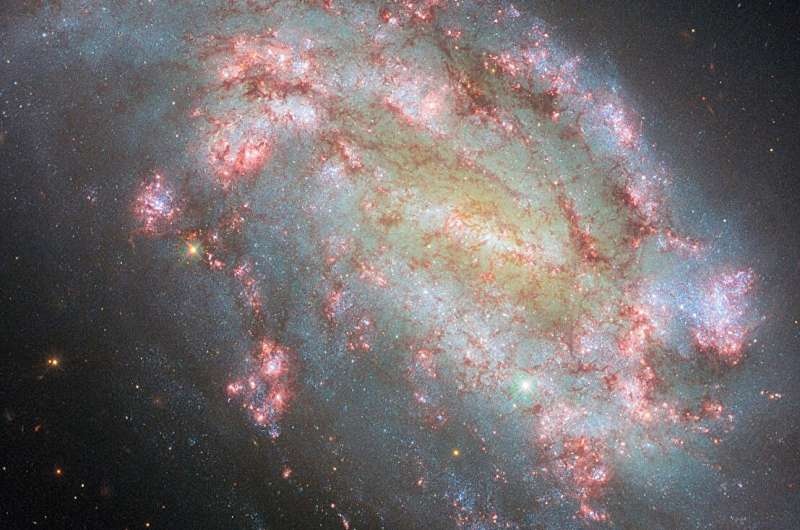Hubble Space Telescope’s latest multiwavelength image reveals the stunning details of galaxy NGC 1559, shedding light on its star formation and astrophysical processes.

A Galaxy’s Multiverse Unveiled
The magnificent galaxy featured in this NASA/ESA Hubble Space Telescope image is NGC 1559, a barred spiral galaxy located in the constellation Reticulum, approximately 35 million light-years from Earth.
What makes this image truly remarkable is that it is a composite of 10 different Hubble images, each filtered to collect light from a specific wavelength or range of wavelengths. This wide range of wavelengths, spanning from ultraviolet through visible light and into the near-infrared spectrum, allows astronomers to study a wealth of information about the galaxy’s astrophysical processes.
One notable example is the red 656-nanometer filter used in the image. This filter captures the light emitted by ionized hydrogen atoms, a phenomenon known as H-alpha emission. When new stars form in a molecular cloud, the ultraviolet light they emit ionizes the surrounding hydrogen gas, causing it to glow with this distinct H-alpha light. By using Hubble’s filters to detect only this specific wavelength, astronomers can reliably identify areas of active star formation, known as H II regions, which are visible in the image as bright red and pink patches filling NGC 1559’s spiral arms.
Unlocking the Secrets of Galaxy Formation
This multiwavelength image of NGC 1559 is the result of a collaborative effort, with data from six different Hubble observing programs spanning from 2009 all the way up to 2024. Teams of astronomers from around the world proposed these programs with a variety of scientific goals, ranging from studying ionized gas and star formation to following up on a supernova and tracking variable stars as a contribution to calculating the Hubble constant.
The wealth of data collected by these programs provides a comprehensive understanding of the galaxy’s astrophysical processes. By analyzing the different wavelengths of light, astronomers can gain insights into the formation and evolution of NGC 1559, as well as the broader processes that shape the structure and dynamics of spiral galaxies.
For example, the detection of H-alpha emission not only reveals areas of active star formation, but also helps scientists understand the complex interplay between gas, dust, and stellar activity within the galaxy. Additionally, the presence of variable stars can provide clues about the galaxy’s distance and the rate of its expansion, contributing to the ongoing effort to refine the Hubble constant, a key parameter in our understanding of the universe’s evolution.
Conclusion
The new multiwavelength image of galaxy NGC 1559 is a testament to the incredible capabilities of the Hubble Space Telescope. By capturing a wide range of wavelengths, astronomers can now delve deeper into the galaxy’s secrets, unraveling the intricate processes that shape its structure and evolution. This data-rich image serves as a valuable resource for the scientific community, inspiring future research and advancing our understanding of the cosmos. As Hubble and the James Webb Space Telescope continue to explore the wonders of NGC 1559, the insights they provide will undoubtedly shed new light on the mysteries of galaxy formation and the ever-evolving universe.
